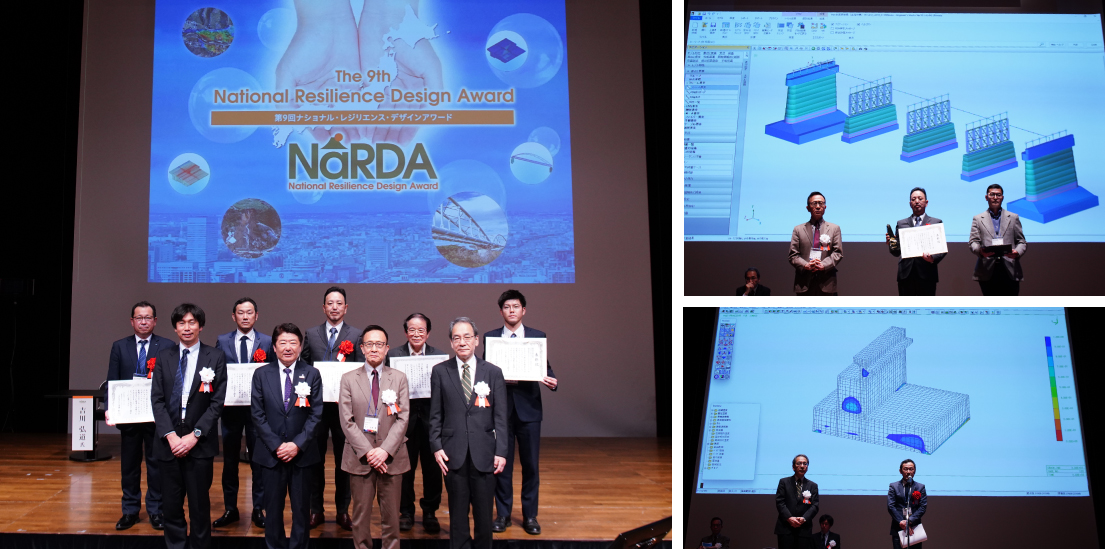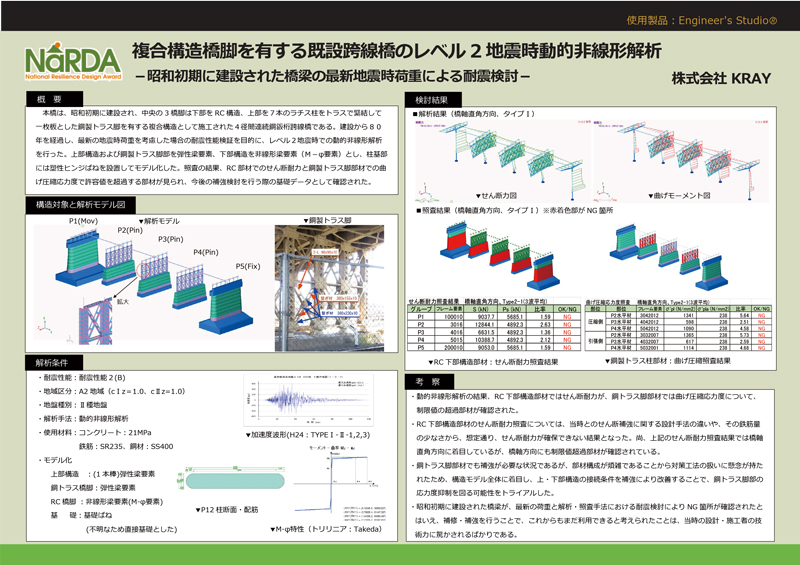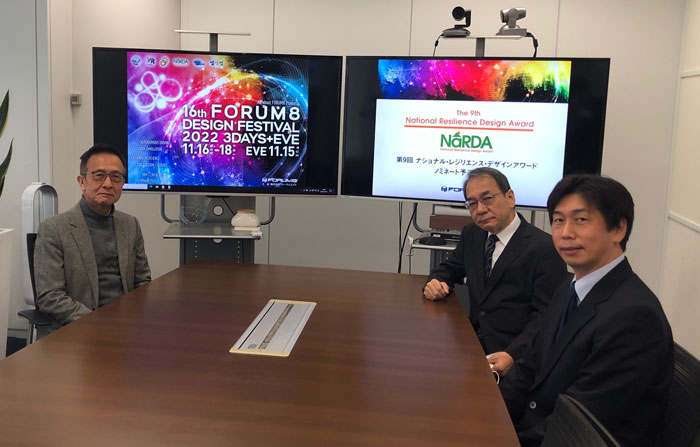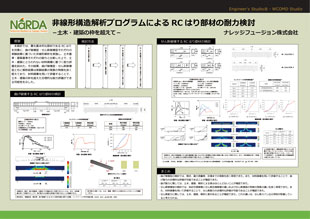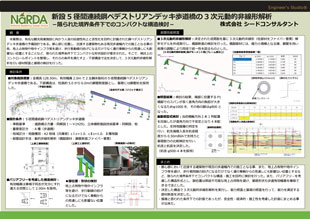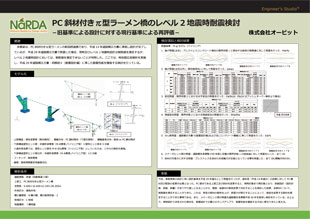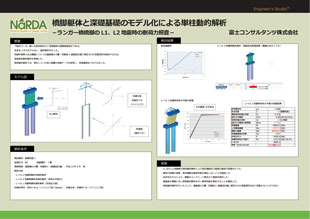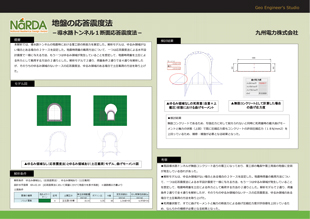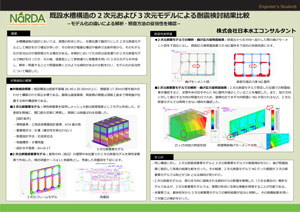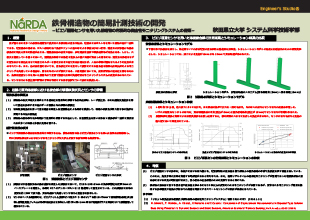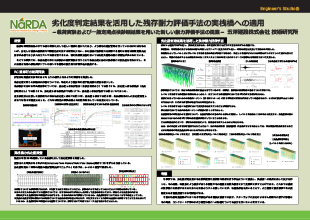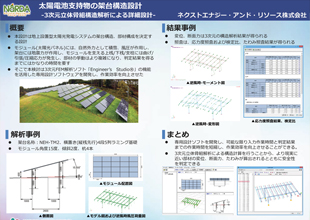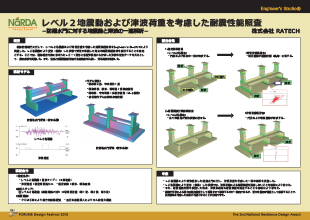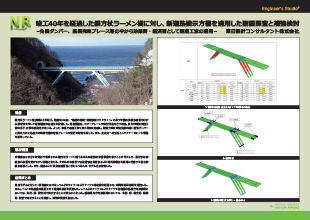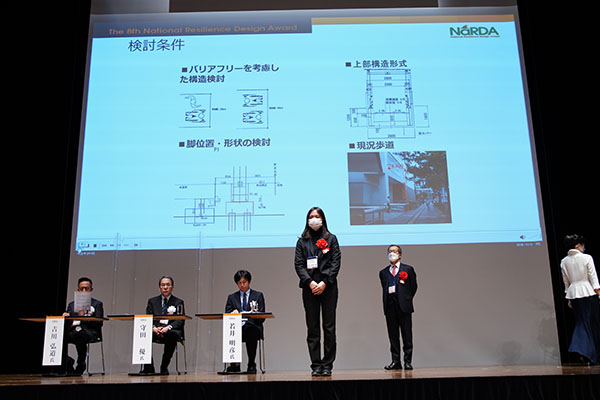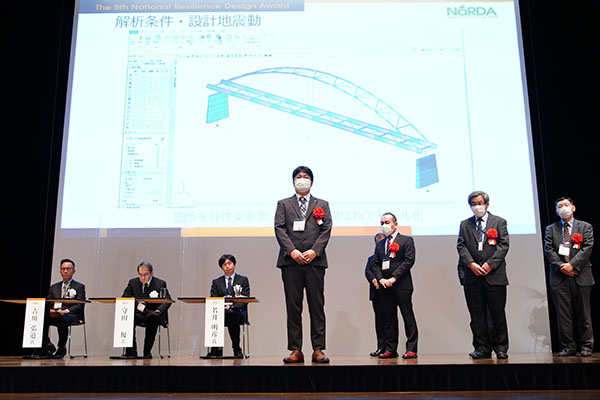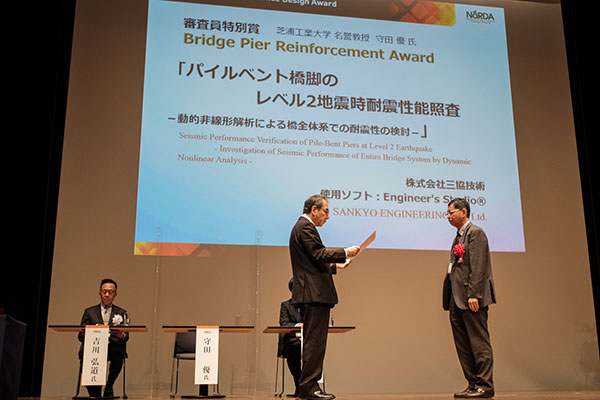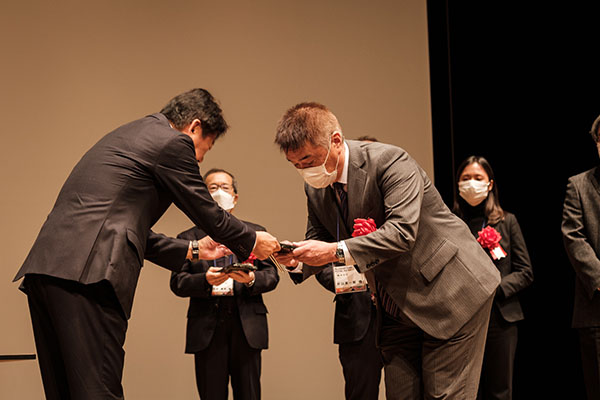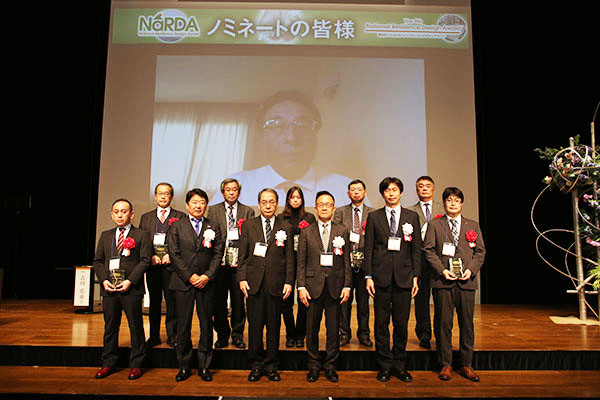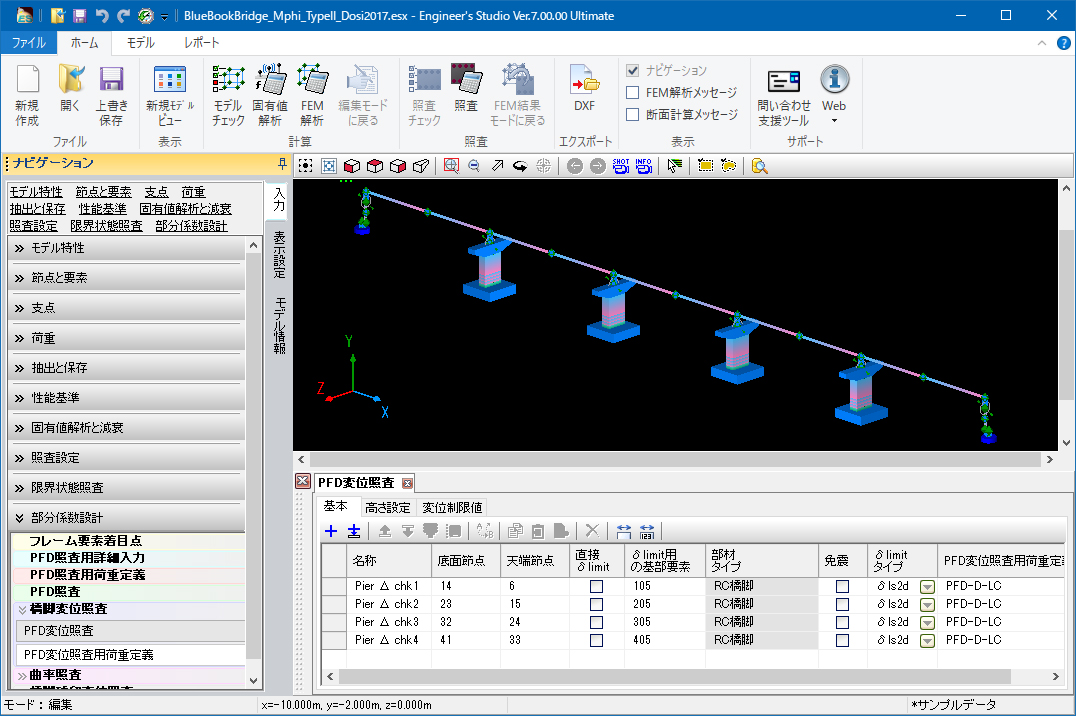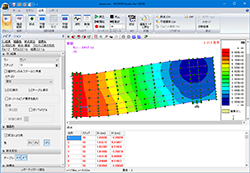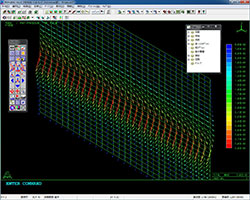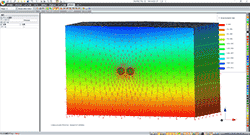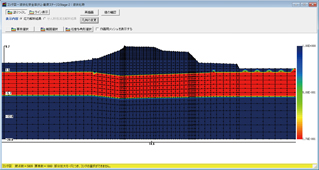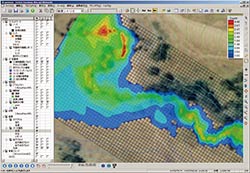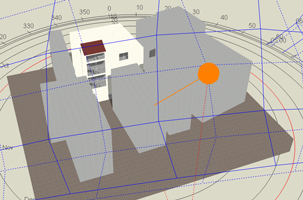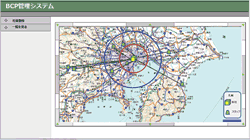Results Announcement
After careful consideration by juries, Grand Prix, 2nd Prize, and 3 Honorable Judge Award have been selected. On November 18th 2022, the Awards Ceremony was held at Intercity Hall.
▲Awards Ceremony (Nov. 18th 2022 at Shinagawa Intercity Hall)
-
Grand Prix (Highest Award)
KRAY Inc.
Level 2 Earthquake Dynamic Nonlinear Analysis of Existing Overpass with Composite Piers
-Verify a bridge constructed in the early Showa period under the latest seismic loads--
Program Used: Engineer's Studio®
This bridge is a 4-span continuous steel plate girder overpass constructed in the early Showa period. The central three piers are of RC structures in the lower part, and the upper part is a composite structure with steel truss legs consisting of seven lattice columns connected with trusses to form a single plate. It has passed over 80 years since its construction, and a dynamic nonlinear analysis was conducted at the level 2 earthquake to verify the seismic performance of the bridge under the latest seismic loading. The superstructure and steel truss legs were modeled as elastic beam elements, and the substructure as a nonlinear beam element (M-φ element), with plastic hinge springs at the column bases. As a result of the verification, the shear capacity of the RC members and the bending and compressive stress of the steel truss legs exceeded the allowable values, which were confirmed as basic data for future reinforcement studies.
-
2nd Prize (Excellence Award)
Hagihara Giken Co., Ltd.
Preliminary Study of Thermal Cracking Before Construction of New Bridge Abutments
-Analysis and countermeasure based on the crack control guideline for mass concrete-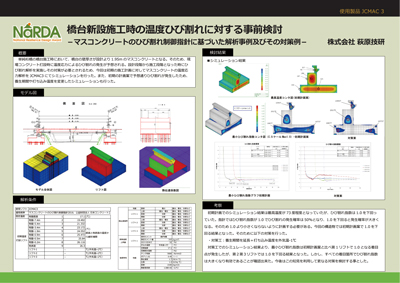 Program Used: JCMAC3
Program Used: JCMAC3
As for the construction of the abutment of a simple girder bridge, the abutment wall was mass concrete of 1.95 m thick according to the design. Therefore, cracking due to thermal stress was expected to occur when the in-situ concrete was placed, and the thermal stress analysis of the mass concrete was conducted with JCMAC3 for the initial construction plan. In addition, cracking occurred as expected in the initial plan, simulations were conducted with different curing periods and pouring temperatures. -
Honorable Judge Award (Prof. Hiromichi Yoshikawa)
Structural Performance Evaluaton AwardChikyu Giken Consultant
Re-analysis of Existing Water Distribution Basins and Verification of Reinforced Seismic Performance
-Reinforcement plan to take measures against NG for normal case while keeping water distribution functionality-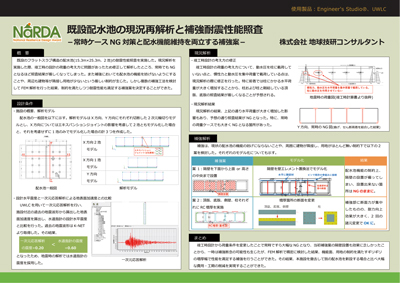 Program Used: Engineer's Studio®, Dynamic effective stress analysis for ground UWLC
Program Used: Engineer's Studio®, Dynamic effective stress analysis for ground UWLC
Seismic performance verification was conducted for an existing water distribution reservoir. The analysis for the existing conditions found that there was a problem with the design load concept at the time of construction. After fixing it and performing an analysis again, the result became so strict that it was NG even in normal time. In addition, severe restrictions were imposed on the reinforcement, for example, the reinforcement should have not interfered with the function of the water distribution reservoir, and there are not so many vacant sites for construction due to buildings around the reservoir. However, after considering several reinforcement methods and performing FEM analysis, a reinforcement plan that satisfied the constraints and the seismic performance was determined. -
Honorable Judge Award (Prof. Masaru Morita)
Water Supply Resilience AwardWakasuzu Consultants Co., Ltd.
Liquefaction Analysis of Water Pipes
-Ground deformation due to liquefaction and its impact on pipelines- Program Used: Dynamic effective stress analysis for ground UWLC
Program Used: Dynamic effective stress analysis for ground UWLC
A seismic response analysis was performed to check the response of an agricultural canal pipe in liquefied ground during an earthquake. Three cross sections were used as the analytical model. The cases of normal backfilling, curing the surrounding area with a concrete box, and considering external forces separately because it corresponds to a bending section were considered. The results of the study showed that liquefaction would be limited to near the surface layer and that no significant deformation would occur. Data processing such as wavelength calculation and thinning was performed on the response waveforms. -
Honorable Judge Award (Prof. Akihiko Wakai)
Multi-stage Process Analysis AwardSK Engineering
Impact Study of Propulsion Pipe Shaft Neighboring Work
-Impact analysis of shaft construction near railroad tracks-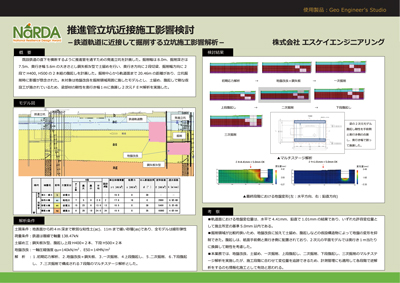 Program Used: Geo Engineer's Studio
Program Used: Geo Engineer's Studio
A starting shaft was planned to place the propulsion pipe crossing directly under the existing railroad. The excavation width was 8.0 m, the excavation depth was 7.5 m, and the length was 5.6 m. Steel sheet piles type IV were used for earth retaining, and a two-stage cut beam was planned in the length direction and two sets of H400 and H500 wales in the excavation width direction. The distance from the center of excavation to the track surface was 20.46 m, and there were concerns about the impact during shaft excavation. The model was designed with ground improvement around the excavation area and rigid temporary structures with retaining and wale, so the stiffness of the beam members was converted to a length of 1 m and a 2-dimensional FEM analysis was performed. -
Nomination Award
Knowledge Fusion Co., Ltd.
Dynamic Analysis of Bridges Using Earthquake Motion Predicted by RNN
-Application of AI technology in the field of disaster prevention- Program Used: Engineer's Studio®
Program Used: Engineer's Studio®
In Japan, it is strongly pointed out that large-scale earthquakes such as the Nankai Trough earthquake and an earthquake directly under the Tokyo metropolitan area will occur soon. In order to protect infrastructure from unprecedented major earthquakes, it is important to predict future seismic motions with greater accuracy than ever before. In recent years, AI technology has made remarkable progress, and this work attempted to predict future earthquake ground motions using RNN, which can handle time-series data. As a result, it was confirmed that even bridges that were considered to satisfy the seismic performance under the conventional design earthquake motion did not satisfy one under the earthquake motion predicted by RNN. This work shows an example of the application of AI technology in the field of disaster prevention. -
Nomination Award
Yabu Doken Co., Ltd.
Crack Examination by Temperature Stress Analysis of Caisson Foundation and Countermeasures
-Example of cracking prevention by pipe cooling-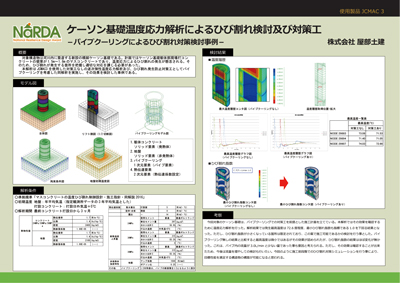 Program Used: JCMAC3
Program Used: JCMAC3
The subject structure was a new pier caisson foundation to be constructed in a river. The planned cast-in-place concrete for the caisson foundation was mass concrete with a wall thickness of 1.5 m to 1.8 m. Cracking due to thermal stress was a concern. Therefore, it was necessary to identify the locations where cracks would occur and take appropriate measures. This analysis using JCMAC3 is a case study of the sequential elastic temperature stress analysis without countermeasures, and the same analysis considering pipe cooling as a countermeasure to prevent cracks. -
Nomination Award
Ube Industries Consultant Co.,Ltd.
Seismic Performance Verification of Arch Channel Bridge
-Analysis of plain concrete bridge using frame element and flat plate element- Program Used: Engineer's Studio®
Program Used: Engineer's Studio®
Arch aqueduct bridges, such as the Tsujunkyo Bridge, were originally constructed as agricultural waterways, but today they are of great scenic and civil engineering heritage value. The bridge is an unreinforced arch aqueduct, and its main structure consists of a substructure (columns), arch and channel sections. Between the arch and channel sections is filled with concrete. Although it is possible to model the padded concrete section as a rigid body, the entire bridge was modeled using frame elements and flat plate elements to approximate the actual structure as closely as possible. And static and dynamic analyses were conducted to verify the seismic performance against level 2 earthquake motion. -
Nomination Award
FUJI Consultants Co.,Ltd.
Seismic Performance Verification of a Simple Steel Truss Bridge Built in the 1950s
-The wisdom of our forefathers that can be realized when a major earthquake occurs-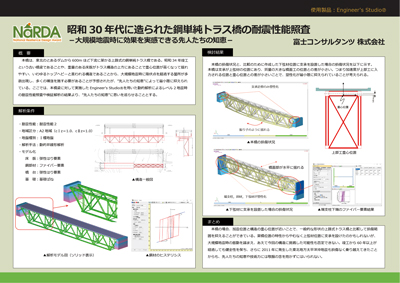 Program Used: Engineer's Studio®
Program Used: Engineer's Studio®
This bridge is a simple steel truss deck bridge. Because it is an old bridge, completed in 1959, and has a so-called "top-heavy" structure in which the heavy floor slab is above the truss structure, it was anticipated that many points would exceed the yield point at an event of a major earthquake, requiring a great deal of reinforcement. However, the "wisdom of our ancestors" has kept the damage and repair to a minimum. In this work, we will consider the "wisdom of our ancestors" based on the results of the seismic performance verification and validation analysis of the Level 2 earthquake by dynamic analysis. -
Nomination Award
Kitacon Corporation
Seismic Performance Verification of River Bridges with Box Structures
-Static nonlinear analysis of box and piles as a whole- Program Used: Engineer's Studio®
Program Used: Engineer's Studio®
This project was designed as a triple box culvert structure to replace a river bridge. The former bridge was a bridge structure, but it was difficult to secure a margin height under the girder or to secure a construction yard and acquire land due to the existence of an intersection, etc. That was why the box culvert structure was adopted for the new bridge. Because of the conditions such as a pile foundation structure in a triple box culvert, it would not be within the application of "conventional type box culvert" covered by the guidelines of culvert work. Therefore, the seismic design was conducted using static nonlinear analysis based on a framework in which the box culvert and piles are integrated, referring to the specifications for highway bridges and calculation examples for sluice gates and weirs. -
Nomination Award
Sanei Sekkei
Impact Study of Sewer Facility Neighboring Work
-Impact mitigation by excavation incorporating the main body construction-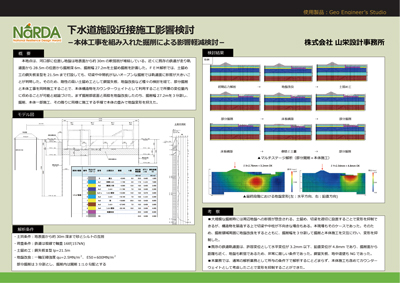 Program Used: Geo Engineer's Studio
Program Used: Geo Engineer's Studio
The site was located at the mouth of an estuary, where a soft layer had accumulated approximately 30 m below the ground surface. The existing railroad ran nearby, and a 6 m deep and 27.2 m wide earth retaining excavation from a point 28.5 m from the track surface was planned. FEM analysis showed that even if steel sheet piles Type III were driven up to 21.5 m, the open excavation without cut beams or intermediate piles would have a significant impact on the track surface. Therefore, after various studies, including steel pipe sheet piles as rigid earth retaining works and ground improvement, it was concluded that it would be possible to keep the displacement within the required amount by using the main structure as a counterweight by simultaneously constructing the partial excavation and the main body.
Overview
With the growing desire for society to build lasting structures that can withstand the tests of disasters, NaRDA was established in 2014 to recognize those who are taking action. Focusing on many different disciplines from civil engineering, to hydroengineering, and disaster prevention. These contributions will be awarded and will become a key source of information and technical study for the future.
Submission Requirements
Content that directly or indirectly contributes to the overall improvement to national resilience, similar but not limited to disaster prevention and mitigation, rational design methods, BCP, and risk management.
Application / Schedule
- Submission Conditions
Mandatory Requirements
1.Title and subtitle of work: 20-40 characters
2.Outline of work: 150-200 characters
3.Poster:A1A1 landscape (Purpose/contents are simply described)
>>Poster Template (Word、111KB)
4.Report (Purpose, methods, results, limitations, etc.): 2-10 pages
>>Report Template (Word, 58KB)
5.Input Data (Result File)
6. List of Products UsedOptional
1. Animation, Videos
2. Presentation slidesLanguages
English or Japanese only
- Destination of Submission
Please tell your contact person of FORUM8 staff and send it to him/her.
- Schedule
-
- Mon. Oct. 17th, 2022
- Deadline for Application
- Tue. Oct. 25th, 2022
- Nomination Work Screening
Fri. Nov. 18th, 2022
- Announcement and Awards Ceremony
Venue: Shinagawa Intercity Hall
- Copyright of Submitted Work
-
The copyright of the VR data of the winning work belongs to the applicant.
Although the submitted data will not be distributed, FORUM8 will edit and process output images, videos, etc. for the data, works and deliverables produced by the author, and will make external presentations, research presentations, sales activities, As a public relations activity, you have a secondary license right such as publication/introduction on media such as HP, public relations magazines, books, magazines and newspapers.
- Inquiries for Application
TEL:03-6894-1888 FAX:03-6894-3888
E-mail:forum8@forum8.co.jp
Awards / Prizes

Grand Prix(The highest award)
raytrek high-performance laptop, Book gift cards (JPY50,000), Trophy, Certificate
2nd Prize (Excellence Award)
GALLERIA laptop, Book gift cards (JPY20,000), Certificate
Honorable Judge Award
Shade3D/Game programming PC, Book gift cards (JPY10,000), Certificate
Nomination Award
Book gift cards (JPY5,000), Plaque
Juries
-

Chair
Prof. Hiromichi Yoshikawa
Honorary Prof., Tokyo City University
Waseda University's Faculty of Science and Engineering Graduate with a specialization in Construction. Doctorate of construction engineering. Specializes in seismic design, earthquake risk, and reinforced concrete. Recipient of JSCE awards, Yoshida Award, etc., and the author of 7 books.
-
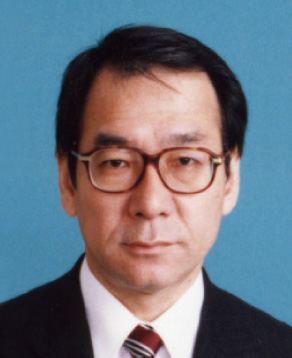
Prof. Masaru Morita
Honorary Prof., Shibaura Institute of Tech.
Professor of the Shibaura Institute of Technology's department of Civil Engineering, Faculty of Engineering. Specializes in urban hydrology, groundwater hydrology, and flood risk management. Author of "Groundwater Talks - The Crisis of Invisible Resources" (Iwanami Shinsho).
-
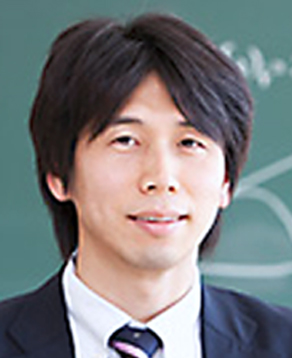
Prof. Akihiko Wakai
Professor, Gunma Univ. Graduate School of Science and Eng.
Professor of Gunma University's Graduate School of Environmental Physiology and Engineering. Specializes in disaster prevention, earth and foundationional disasters, etc. Research on computer-based phenomenon prediction, mechanisms for extreme weather/major earthquakes, and disaster mitigation measures.
Past Award Winners
Our level of competition is increasing every year as we see projects and works from various fields in structural analysis, geotechnical engineering, hydraulic engineering, disaster prevention and risk assessment.
-
 Program Used: Engineer's Studio®
Program Used: Engineer's Studio®
This work is a seismic survey of a 59-meter-long Langer stiffening type water pipe bridge in accordance with the guidelines for seismic construction methods for waterworks facilities. In the basic design of the seismic reinforcement, the seismic resistance of the bridge was verified by nonlinear dynamic analysis, and the reinforcement methods were compared for the areas where the bearing capacity was insufficient. As a result of the comparative study, the thickening of the back side was applied for the movable side, and the carbon fiber winding and the thickening of footing for the fixed side. As for the temporary construction method, the clamping method was used after considering the river conditions such as the river inhibition ratio. In the seismic diagnosis survey, detailed investigations such as pipe thickness measurement, neutralization test, and compressive strength test were carried out, and a seismic resistance verification was carried out to propose the proper reinforcement method. -
8th 2nd Prize (Excellence Award)
United Seismic Performance Verification of Civil Engineering Facility and Architectural Facility
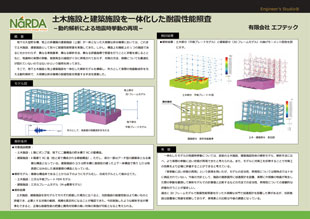 Program Used:Engineer's Studio®
Program Used:Engineer's Studio®
The seismic performance of large-scale drainage pump stations, which consist of a large underground water storage tank and a multi-story building facility above ground, has been verified separately for civil engineering facility and building facility. However, there comes a question that it is inconsistent to use different compliance standards, different analysis methods, and different evaluation indices for verification of those structures, even though the facility is structurally and functionally the same. Also, there is another question whether the actual behaviors during earthquakes and the process of damage generation have not been sufficiently reproduced, and whether the methods and scale of countermeasures have not been optimized. Here, this work proposes a method to verify the seismic performance of large-scale drainage pumping stations through dynamic analysis, by creating an analytical model integrating underground civil engineering facilities and above-ground building facilities, and applying actual seismic motion waveforms as external forces.
-
8th Honorable Judge Award
(Prof. Hiromichi Yoshikawa)
Structural Performance Evaluation AwardStudy on Bearing Capacity of RC Beam Members Using Nonlinear Structural Analysis Program
-
8th Honorable Judge Award
(Prof. Masaru Morita)
Bridge Pier Reinforcement AwardLevel 2 Seismic Performance Verification for Pile-Bent Piers
-
8th Honorable Judge Award
(Prof. Akihiko Wakai)
Urban Amenity Design Award3D Dynamic Nonlinear Analysis of a New 5-Span Continuous Steel Pedestrian Deck Bridge
-
8th Nomination Award
Level 2 Seismic Study of π-Shaped Rigid-Frame Bridge with PC Diagonal Members
-
8th Nomination Award
Single Column Dynamic Analysis by Modeling Pier Frame and Deep Foundation
Past Award Winners PickUp
-
7th Grand Prix
Nihon Suiko Consultant Co.,Ltd
Comparison of seismic test result by using 2D and 3D model of existing water tank
-
5th Grand Prix
PENTA-OCEAN CONSTRUCTION CO., LTD.
Residual Strength Evaluation Method using Degradation to check Jetties
-
3rd Grand Prix
Nippon Concrete Industries Co., Ltd.
PC-wall to Retrofit Walls and Analysis During High Seismic Events
-
1st Grand Prix
Tonichi Design Consultant Co., Ltd.
Specifications for Highway Bridges Using 40-year-old Batter Brace Bridge
-
8th NaRDA (2021)
-
- [Grand Prix (Highest Award)]
NiX Co., Ltd.
- Seismic Study of Existing Steel Pipe Arch Water Pipe Bridge
- [2nd Prize (Excellent Award)]
F-tech Inc.
- United Seismic Performance Verification of Civil Engineering Facility and Architectural Facility
- [Honorable Judge Award]
Knowledge Fusion Co., Ltd.
- Study on Bearing Capacity of RC Beam Members Using Nonlinear Structural Analysis Program
SANKYO ENGINEERING Co., Ltd.
- Level 2 Seismic Performance Verification for Pile-Bent Piers
SEED CONSULTANT,INC.
- Three-Dimensional Dynamic Nonlinear Analysis of a New Five-Span Continuous Steel Pedestrian Deck Bridge
- [Nomination Award]
ORBIT Co.,LTD.
- Level 2 Seismic Study of π-Shaped Rigid-Frame Bridge with PC Diagonal Members
FUJI Consultants Co.,Ltd.
- Single Column Dynamic Analysis by Modeling Pier Frame and Deep Foundation
Kyushu Electric Power Company, Incorporated
- Response Seismic Method of Ground
- [Grand Prix (Highest Award)]
-
7th NaRDA (2020)
-
- [Grand Prix (Highest Award)]
Nihon Suiko Consultant Co.,Ltd
- "Comparison of seismic test result by using 2D and 3D model of existing water tank"
- [2nd Prize (Excellent Award)]
Naigai Engineering Co., Ltd.
- "Seismic performance test using observed seismic motion"
- [Honorable Judge Award]
Sanpoh Co.,LTD
- "Rebar interference check using reverse T-type abutment CIM model"
Civil Engineering and Information Technology Consultants Inc.
- "Flood analysis in urban area"
Geo Formation
- "Influence of construction near railroad"
- [Nomination Award]
Sanei Sekkei
- "3D FEM beam model of a water treatment facility"
Aratani Civil Engineering Consultants CO.,LTD.
- "Seismic measure for continuous girder bridge using existing seismic bearing"
Epoch Design
- "Dynamic Ground Analysis on Tunnel"
- [Grand Prix (Highest Award)]
-
6th NaRDA (2019)
-
- [Grand Prix (Highest Award)]
Akita Prefectural University Faculty of Systems Science and Technology
- "Development of simple measurement technology for steel structures"
- [2nd Prize (Excellent Award)]
F-tech Inc.
- "Flood analysis of rivers in mountain area"
- [Honorable Judge Award]
SHO-BOND CORPORATION Nagoya Branch
- "Validity evaluation of reaction force for bearing design by difference of analysis model"
Knowledge Fusion Co., Ltd.
- "Disaster countermeasures for water supply facilities considering multi-hazards"
Kyushu Civil Engineering
- "Dike ground analysis"
- [Nomination Award]
JR Kyushu Consultants Company
- "JR Kagoshima Main Line track underlay propulsion impact analysis"
Namura Shipbuilding Co., Ltd.
- "Verification of installation method by cable erection method"
Morimatsu Industry Co., Ltd.
- "Proposal of water tank with seismic isolation device for huge earthquakes"
- [Grand Prix (Highest Award)]
-
5th NaRDA (2018)
-
- [Grand Prix (Highest Award)]
Institute of Technology, PENTA-OCEAN CONSTRUCTION CO., LTD.
- "Residual strength evaluation method using degradation level check to jetties"
- [2nd Prize (Excellent Award)]
Knowledge Fusion Co.,Ltd.
- "Seismic performance evaluation according to damage on material"
- [Honorable Judge Award]
KATAHIRA & ENGINEERS INC.
- "Stress analysis on the branch point of steel deck box girder bridge"
Kagoshima University
- "CFD analysis simulation of traditional architecture"
NIHON SAMICON CO., LTD.
- "Seismic performance verification for PC snow shed against L2 earthquake"
- [Nomination Award]
Cosmo Consultants Co., Ltd
- "Seismic verification of coastal embankment"
Marine Support Engineering
- "Seismic performance verification for additional piles against L2 earthquake and tsunami "
APPLIED TECHNOLOGY CO., LTD.
- "Seismic test for a steel intake tower"
Wakasuzu Co., Ltd.
- "Evaluating damage on existing bridge foundation caused by L2 earthquake"
- [Grand Prix (Highest Award)]
-
4th NaRDA (2017)
-
- [Grand Prix (Highest Award)]
Next Energy & Resources Co., Ltd.
- "Design of solar cell support structure"
- [2nd Prize (Excellent Award)]
Nippon Concrete Industries Co., Ltd.
- "Consistency by full scale experiment and nonlinear pushover analysis for PC-wall"
- [Honorable Judge Award]
CIVIC ARTS Consulting Inc.
- "Seismic performance evaluation of eight-continuous water gate"
APPLIED TECHNOLOGY CO., LTD.
- "Seismic performance check of hydraulic steel pipe for power generation"
Japan Association of Diaphragm Wall
- "Strength test analysis by steel diaphragm wall method-II"
- [Nomination Award]
Takenaka Corporation
- "Annual load calculation analysis of exterior"
Ahbo, Inc.
- "Analytical review on cracks in a lid of side ditch"
Wakasuzu Consultants Co., Ltd. Oita office
- "Ground analysis of gas pipe displacement"
- [Grand Prix (Highest Award)]
-
3rd NaRDA (2016)
-
- [Grand Prix (Highest Award)]
Nippon Concrete Industries Co., Ltd.
- "High seismic retrofitting of freestanding retaining wall by using PC-Wall and reasonable performance verification type seismic design method"
- [2nd Prize (Excellent Award)]
Association of road and bridge structure, Ministry of Land, Infrastructure, Transport and Tourism. Central Regional Development Bureau
- "Utilize Engineer's Studio® for personnel training"
- [Honorable Judge Award]
A x C
- "Experimental result about sewerage facilities if applying non-linear FEM analysis, and limit value based on the result"
Oita National College of Technology
- "Shallow water equations based tsunami attack simulation with the idea of disaster prevention on software"
APPLIED TECHNOLOGY CO.,LTD.
- "Verification of tsunami load against shell-type roller gate by using FEM"
- [Nomination Award]
Totetsu Mfg. Co.,Ltd.
- "Structure characteristic understanding of rainwater storage and infiltration facilities "aquapalace method""
Sankyo Technology Co., Ltd.
- "Seismic performance verification and reinforcement analysis of the existing RC ramen pier"
JAPAN-CHINA CONSULTANT Co., LTD Nagoya Office
- "Seismic verification of a water pumping facility"
- [Grand Prix (Highest Award)]
Product Info
FEM Analysis
Engineer's Studio® Dynamic non-linear analysis of 3D laminated plates and cables
FEMLEEG Comprehensive finite element method analysis system
WCOMD Studio
Geotechnical Analysis(GeoFEAS VGFlow / Geo Engineer's Studio / 2D elasto-plastic ground analysis GeoFEAS2D / Dynamic Stress Analysis for Ground UWLC / 3D Slope Stability Analysis LEM3D / 2D seepage analysis (VGFlow)
UC-1 Series
Structural Analysis、Bridge Structures、Bridge Substructures、Foundation Work、Temporary Construction、Road/Earth work、Waterworksetc.
Referral Program
Analysis Support Services


